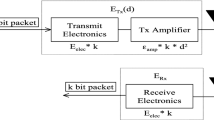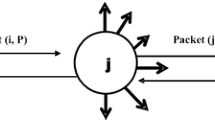Abstract
Wireless Sensor networks are capable of creating any dynamic s–hort-term network with a group of sensor nodes without any previous centralized or infrastructure administration. Each node in the network has only alimited range of wireless transmission, and so it is essential fora node to transmit data with the help of further nodes in the set of connections to its destination,generally the base station. The major problems perceived while designing the routing protocol in sensor networks, relates to the construction of an effect utilization device of the harshly restricted resources present in the network, especially the limited energy. The important factor to be considered in WSN from investigator relates to securing energy efficiency for useto the extent achievable. Existing routing protocol highlights only the extension of the duration of the network or just focusing protection mechanism with overwhelming large amountof energy. This paper introduces HSEERP (Hierarchical Secure and Energy EfficientRouting Protocol) forrouting protocol. It selects a best path among two nodes, to enable extension of the derivation of the chosen path of the network. It is also adequately resistive to a fewparticularthreats that comprise the attributes of getting entire traffic through the malicious nodes by advertising a gorgeous way to the destination. The implementation of present protocol was evaluatedand theresults showed the superiority of this proposed protocol to theprevious protocol techniques in terms of throughput 94%, energy efficiency 95%, malicious node detection 94%, time complexity is 64 ms, routing overhead is 31.3% and packet delivery ratio 95%for getting satisfactory duration of the network.










Similar content being viewed by others
Data availability and statement
The datasets generated during and/or analyzed during the current study are available from the corresponding author on reasonable request.
References
de Fuentes JM, Gonzalez Manzano L, Mirzaei O (2016) Privacy Models in Wireless sensor networks: A Survey. J Sens 10(1155):1–18
Yang Q, Zhu X, Hongjuan Fu, Che X (2015) Survey on Security Technologies on Wireless Sensor network. J Sens 10(1055):1–9
Sarkar A, Murugan TS (2016) Routing Protocols for Wireless Sensor Networks: What the Literature Survey. Alexandria Eng J 55(4):3173–3183
Sajwan M, Gosain D, Sharma AK (2018) Hybrid Energy-efficient multi-path routing for wireless sensor networks. Comput Electr Eng 67(1):96–113
Bok K, Lee Y, Park J, Yoo J (2016) An Energy Efficient Secure Scheme in Wireless Sensor Networks 10(1155):1–11
Zaib ullah, (2020) A Survey on Hybrid, Energy Efficient and Distributed (HEED) Based Energy Efficient Clustering Protocols for Wireless Sensor Networks. Wirel Pers Commun 112(2):2685–2713
Zhang J, Feng X, Liu Z (2018) A grid-based clustering algorithm via load analysis for industrial internet of things. IEEE Access 6:13117–13128
Essa A, Al-Dubai AY, Romdhani I, Eshaftri MA (2017) A new dynamic weight-based energy efficient algorithm for sensor networks. Smart grid inspired future technologies 10(100):195–203
Tang M, Lin X, Palesi M (2015) Routing pressure: A channel-related and traffic-aware metric of routing algorithm. IEEE Trans Parallel Distrib Syst 26(3):891–901
Sharma A et al (2023) MHSEER: A Meta Heuristic Secure and Energy Efficient Routing Protocol for Wireless Sensor Networks-Based Industrial IOT. Energies 16(10):1–10
Balachandra M, Prema KV, Makkithaya K (2014) Multiconstrained and multipath QoS aware routing protocol for MANETs. Wireless Netw 20(8):2395–2408
Asif M, Khan S, Ahmad R, Sohail M, Singh D (2017) Quality of Service of Routing Protocols in Wireless Sensor Networks: A Review. IEEE Access 5(3):1846–1871
Ghosal A, Halder S (2013) Intrusion detection in wireless sensor networks: Issues, challenges and approaches. In: Wireless Networks and Security. Signal Commun Technol 329–367
Troja S, Alvizu R, Maieur G (2019) Reinforcement learning for service function chain reconfiguration in NFV- SDN metro core optical networks. IEEE Access 7(2019):167944–167957
Safaa SS, Mabrouk TF, Tarabishi RA (2021) An improved Energy-efficient head election protocol for clustering techniques of wireless sensor network. Egypt Inform J 22(4):439–445
Gopi Saminathan Arumugam and Thirumurugam Ponnuchamy (2015) EE-LEACH: Development of energy-efficient LEACH Protocol for data gathering in WSN. EURASIP J Wirel Commun Netw 10(1186):1–9
D Guo, L Xu (2013) LEACH Clustering Routing Protocol for WSN. Int Conf Info Eng Appl (IEA) 2012. 219(Springer, London, 2013)153–160
Jaiswal K, Anand V (2021) A Grey-Wolf based Optimized Clustering approach to improve QOS in Wireless Sensor networks for IoT applications. Peer Peer Netw Appl (14)1943–1962
Han K, Luo J, Liu Y, Vasilakos AV (2013) Algorithm design for data communications in duty- cycled wireless sensor networks: a survey. IEEE Commun Mag 51:107–113
Farahzadi HR, Langarizadeh M, Mirhosseini M, Aghda SAF (2021) An improved Cluster information Process in wireless sensor networks to decrease energy consumption. Wireless Netw 27:1077–1087
HarneetKour and Ajay K. Sharma, (2010) Hybrid Energy Efficient Distributed Protocol for Heterogeneous Wireless Sensor Network. Int J Comput Appl 4(6):1–5
Ullah Z (2020) A Survey on Hybrid, Energy Efficient and Distributed (HEED) Based EnergyEfficient Clustering Protocols for Wireless Sensor Networks. Wirel Pers Commun 112(5):2685–2713
Sharma N, Nayyar A (2014) A comprehensive review of cluster based energy efficient routing protocols for wireless sensor networks. Int J Appl Innov Eng Manag 3(1):441–453
Yassen MB, Aljawaerneh S, Abdulraziq R (2016) Secure low energy adaptive clustering hierarchal based on internet of things for wireless sensor network (WSN): Survey. Int Conf Eng MIS (ICEMIS):1–9
Mardini W, Yassein MB, Khamayseh Y, Ghaleb BA (2014) Rotated hybrid, energy-efficient and distributed (R-HEED) clustering protocol in WSN. WSEAS Trans Commun 13:275–290
Chand S, Singh S, Kumar B (2014) Heterogeneous HEED protocol for wireless sensor networks. Wireless Pers Commun 77(3):2117–2139
Azizi T, Beghdad R (2016) Increasing Qos Parameters in WSNs through Spiran-Based Clustered Architecture. Int Conf Ambient Sys Netw Tech (ANT 2016) 83:401–408
Laranjeira LA, Rodrigues GN (2014) Border effect analysis for reliability assurance and continuous connectivity of wireless sensor networks in the presence of sensor failures. IEEE Trans Wireless Commun 13(8):4232–4246
Patwant Singh and Satbir singh (2015) Power Efficient Gathering in Sensor Information Systems Based on Ant Colony Optimization (ACO) in WSN”. Int J Eng Res Tech 4(6):948–951
Zhang H, Li Z, Shu W, Chou J (2019) Ant colony optimization algorithm based on mobile sink data collection in industrial wireless sensor networks. Eurasip J Wirel Commun Netw 10(1186):1–12
Vazhuthi PP, Prasanth A, Manikandan SP, Sowhdaryaan D (2022) A hybrid ANFIS reptile optimization algorithm for energy efficient inter-clustering routing in internet of things – enabled wireless sensor networks. Peer Peer Netw Appl 16(10):1049–1068
Tanmoy Maitra and Subhabrata Barman and Debasis Giri (2018) Cluster –Based Energy-Efficient Secure Routing in Wireless Sensor Networks. Int Conf Info Tech Appl Math 699:23–40
Varun R, Gangwar RC (2019) Hierarchical Energy Efficiency Routing in wireless Sensor Networks and its challenges. Int J Eng Adv Tech 9(1):4024–4027
Hamzah A, Shurman M, Al-Jarrah O, Taqieddin E (2019) Energy-efficient fuzzy-logic-based clustering technique for hierarchical routing protocols in wireless sensor networks. Sensors 19(3):1–23
Fang W, Zhang W, Yang W, Li Z, Gao W, Yang Y (2021) Trust management-based and energy efficient hierarchical routing protocol in wireless sensor networks. Digit Commun Netw 7(4):470–478
Mann PS, Singh S (2017) Energy-efficient hierarchical routing for wireless sensor networks: a swarm intelligence approach. Wireless Pers Commun 92(2):785–805
Khan MK, Shiraz M, Shaheen Q, Butt SA, Akhtar R, Khan MA, Changda W (2021) Hierarchical routing protocols for wireless sensor networks: functional and performance analysis. J Sens 10(1155):1–18
Chaurasia S, Kumar K (2023) ACRA, Adaptive meta-heuristic based clustering and routing algorithm for IOT-assisted wireless sensor networks. Peer Peer Netw Appl 10(1007):1–16
Funding
The authors did not receive support from any organization for the submitted work.
Author information
Authors and Affiliations
Contributions
All authors made an equal contribution to the development of the paper. All authors read and approved the final manuscript.
Corresponding author
Ethics declarations
Ethics approval
This article does not contain any studies with human participants or animals performed by any of the authors.
Conflict of interest
The authors declare no conflict of interest.
Consent to publish
All authors have read and agreed to the published the manuscript.
Additional information
Publisher's Note
Springer Nature remains neutral with regard to jurisdictional claims in published maps and institutional affiliations.
Rights and permissions
Springer Nature or its licensor (e.g. a society or other partner) holds exclusive rights to this article under a publishing agreement with the author(s) or other rightsholder(s); author self-archiving of the accepted manuscript version of this article is solely governed by the terms of such publishing agreement and applicable law.
About this article
Cite this article
D, U.S.R., P, S., Arunkumar, K. et al. A HSEERP—Hierarchical secured energy efficient routing protocol for wireless sensor networks. Peer-to-Peer Netw. Appl. 17, 163–175 (2024). https://doi.org/10.1007/s12083-023-01575-w
Received:
Accepted:
Published:
Issue Date:
DOI: https://doi.org/10.1007/s12083-023-01575-w




